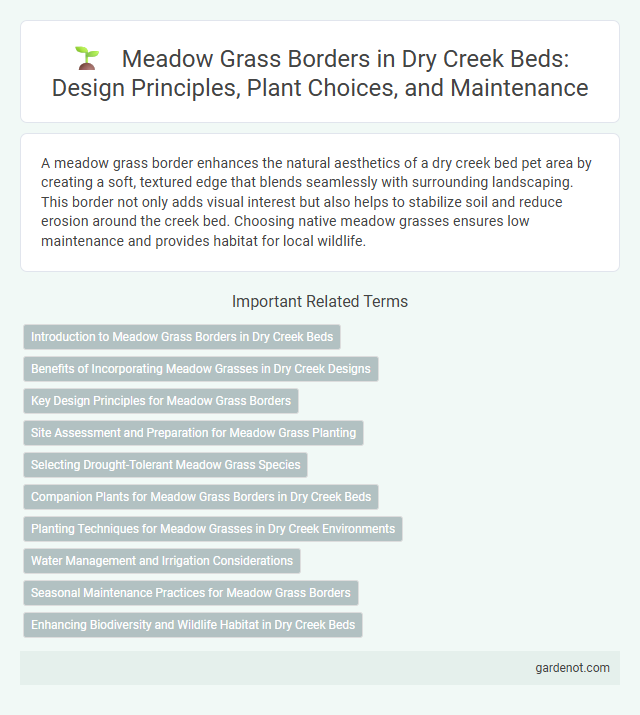A meadow grass border enhances the natural aesthetics of a dry creek bed pet area by creating a soft, textured edge that blends seamlessly with surrounding landscaping. This border not only adds visual interest but also helps to stabilize soil and reduce erosion around the creek bed. Choosing native meadow grasses ensures low maintenance and provides habitat for local wildlife.
Introduction to Meadow Grass Borders in Dry Creek Beds
Meadow grass borders in dry creek beds create a naturalistic edge that enhances erosion control and biodiversity. These grasses, adapted to fluctuating moisture levels, provide habitat for pollinators and contribute to soil stabilization. Integrating native meadow grasses like switchgrass and blue grama fosters ecological balance while adding visual texture to the dry creek landscape.
Benefits of Incorporating Meadow Grasses in Dry Creek Designs
Incorporating meadow grasses in dry creek bed designs enhances soil erosion control by stabilizing the substrate with deep, fibrous root systems. These grasses improve water infiltration and reduce runoff, promoting sustainable drainage management in arid landscapes. Their drought tolerance and low maintenance requirements make meadow grasses an eco-friendly choice for xeriscaping and habitat restoration projects.
Key Design Principles for Meadow Grass Borders
Meadow grass borders thrive when designed with naturalistic planting schemes that emphasize species diversity and seasonal variation to enhance ecological benefits and aesthetic appeal. Selecting native grass species with varying heights and textures creates dynamic movement and depth, while maintaining proper soil conditions and drainage promotes healthy root systems. Incorporating gradual transitions between meadow grasses and adjacent landscape features ensures visual harmony and supports local wildlife habitats.
Site Assessment and Preparation for Meadow Grass Planting
Conduct a thorough site assessment to evaluate soil type, drainage, and sunlight exposure essential for successful meadow grass planting along a dry creek bed. Clear existing vegetation and debris, then loosen the soil to enhance aeration and root penetration. Test soil pH and amend with organic matter to create optimal growing conditions for native meadow grass species.
Selecting Drought-Tolerant Meadow Grass Species
Selecting drought-tolerant meadow grass species such as Blue Grama (Bouteloua gracilis), Buffalo Grass (Bouteloua dactyloides), and Needlegrass (Stipa spp.) ensures resilience in dry creek bed environments. These grasses exhibit deep root systems that maximize water absorption and improve soil stabilization along dry creek borders. Incorporating native species adapted to arid conditions enhances sustainability and reduces irrigation requirements.
Companion Plants for Meadow Grass Borders in Dry Creek Beds
Companion plants for meadow grass borders in dry creek beds include native wildflowers such as Black-eyed Susan, Purple Coneflower, and Butterfly Weed, which enhance biodiversity and attract pollinators. Ornamental grasses like Blue Fescue and Little Bluestem provide texture contrast while thriving in well-drained, low-moisture conditions. Incorporating drought-tolerant perennials like Yarrow and Blanket Flower helps stabilize soil and maintain aesthetic appeal in dry, rocky landscapes.
Planting Techniques for Meadow Grasses in Dry Creek Environments
Planting meadow grasses in dry creek beds requires selecting drought-tolerant species such as blue grama, buffalo grass, or little bluestem that thrive in well-drained soils. Incorporate organic mulch and amend the soil with compost to retain moisture and enhance nutrient availability for young grass roots. Spacing plants adequately ensures airflow and reduces competition, promoting healthy growth along the meadow grass border.
Water Management and Irrigation Considerations
A meadow grass border in a dry creek bed enhances water management by improving soil infiltration and reducing surface runoff, which supports natural irrigation cycles. Selecting native, drought-tolerant grass species minimizes water usage while maintaining plant health during dry periods. Integrating drip irrigation systems ensures precise water delivery, promoting efficient hydration without oversaturation or erosion in the creek bed environment.
Seasonal Maintenance Practices for Meadow Grass Borders
Seasonal maintenance practices for meadow grass borders in dry creek beds include regular mowing to a height of 4-6 inches during late spring to promote healthy growth and prevent invasive species. Spring and fall trimming remove dead material, improving airflow and reducing disease risk while also encouraging vibrant blooming. Applying organic mulch helps retain soil moisture and suppress weeds, essential for sustaining a thriving meadow grass border throughout changing seasons.
Enhancing Biodiversity and Wildlife Habitat in Dry Creek Beds
Meadow grass borders in dry creek beds play a crucial role in enhancing biodiversity by providing habitat and food sources for pollinators, birds, and small mammals. These native grasses stabilize soil, reduce erosion, and improve water infiltration, creating a healthier ecosystem. Integrating diverse meadow species encourages a resilient environment that supports various wildlife and promotes ecological balance in arid landscapes.
Meadow grass border Infographic

 gardenot.com
gardenot.com